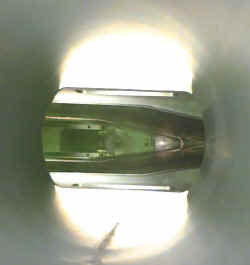Two New Elements

The periodic table has expanded again. A team at the Lawrence Berkeley National Laboratory (LBNL) in California has created elements 116 and 118, which extends the chart into a region long-predicted to contain extra-stable nuclei. The discovery, announced in June and published in the 9 August PRL, was a surprise to most in the field and followed a claimed discovery of element 114 in January. The researchers don’t fully understand why their new reaction scheme worked, but the excitement it generated should lead to many more experiments in this new realm and–they hope–to a better understanding of nuclear structure and stability.
For decades nuclear physicists have been studying the limits of nuclear stability by producing elements with ever more protons and neutrons. Based on the most simple-minded calculations, nuclei with more than about 106 protons should fly apart from the tremendous mutual repulsion of protons, but in the 1970s theorists proposed that stable nuclei might exist at somewhat higher atomic numbers, where proton and neutron “shells” become filled.
This “island of stability” was tentatively confirmed in January, when a team from the Joint Institute for Nuclear Research in Dubna, Russia, announced that an atom of element 114 had lived in their lab for 30 seconds–practically forever in a field where half-lives are usually measured in microseconds. Before that discovery, researchers had made a series of heavy elements by “cold fusion”–a method where the newborn nucleus has relatively little excess energy to shed before assuming a stable ground state–but the Dubna team used “hot fusion.” Based on several years of data, the cold fusion approach seemed unlikely to work for heavier elements, until Robert Smolanczuk of the Soltan Institute for Nuclear Studies in Poland calculated a decent chance for success [Phys. Rev. C 59, 2634 (1999)].
Smolanczuk was visiting LBNL at the time, so a team led by LBNL’s Ken Gregorich decided to give low-energy fusion another chance, although “we were a little bit reluctant,” admits Gregorich, given the conventional wisdom. They aimed a beam of krypton atoms at a lead target and looked for the decay events predicted by Smolanczuk–a “chain” of alpha particle emissions, that would take element 118 to element 116, and continue down to element 104. After ten days of running a beam of a trillion krypton ions per second, the team observed three atoms of element 118.
The team attributes their success in part to a slightly mysterious nuclear reaction that somehow unites the krypton and lead nuclei at close range, despite their mutual repulsion. The strong nuclear force can easily pull two light nuclei together if they get close enough, but with such large nuclei, the electric repulsion can overwhelm that simple effect. Gregorich says the beam has a bit more energy than is needed for the nuclei to meet, so they get close enough for some other reaction–a nuclear shape change or perhaps an exchange of protons–allows the fusion to take place.
Ron Lougheed of the Lawrence Livermore National Laboratory in California worked with the Russian team that found element 114 and says the new experiments put an end to the long search for superheavy elements. “It isn’t just a prediction [now]; there really is added stability at this high neutron number near element 114.” Gregorich and Lougheed both expect a flurry of experiments using this newly discovered pathway to superheavy nuclei; Gregorich even suggests chemical reactions could be studied among these elements in the future.
More Information
All but one author retracted this paper in 2002. Retraction: Phys. Rev. Lett. 89, 039901 (2002) Theoretical analysis in 1999 supported the paper:Phys. Rev. Lett. 83, 1108 (1999)


